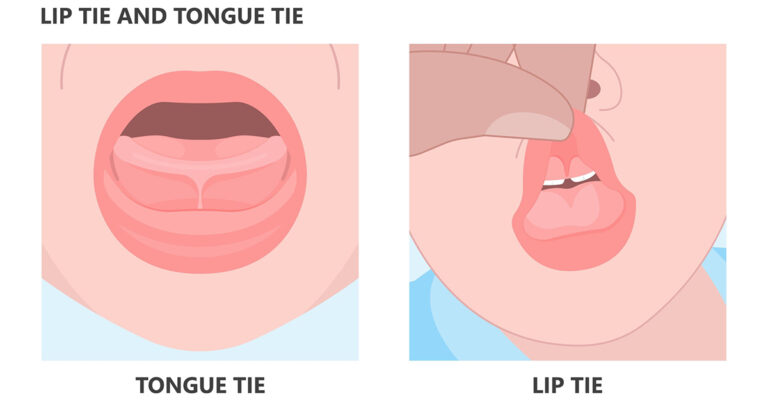Most people have heard of the term “Tongue Tie” before.
But when you’re a parent with concerns about your child’s feeding skills or speech development, it can be important to learn more about what a tongue tie really is.
Ankyloglossia (“tongue tie”) affects an estimated 5% of all newborns, meaning it’s somewhat common. Ankyloglossia is sometimes seen in babies who have difficulty breastfeeding, and children who have trouble making different speech sounds as they get older.
Another condition seen in newborns is a lip tie. A lip tie can also lead to difficulties with feeding, speech and dental hygiene, according to the American Speech Language Hearing Association (ASHA).
The good news is that both tongue ties and lip ties can be corrected to alleviate or prevent symptoms, through a simple procedure known as a Frenotomy. How do you know when a Frenotomy might be needed?
You’ll want to be familiar with the symptoms of a lip tie and tongue tie, when to consider treatment, and what specialists to talk to.
What is Ankyloglossia (“Tongue-tie”)?
If you look in the mirror and lift your tongue up, you’ll see a little web of tissue underneath that looks like a thin line. That’s known as the Frenulum, and it attaches the tongue to the bottom of your mouth.
According to Johns Hopkins Medicine, Ankyloglossia is a condition that occurs when the Frenulum is shortened or thickened, or tethers too closely to the tip of the tongue.
This can restrict the tongue’s range of motion. It may not be able to move as much, or in the correct ways, to allow a child to successfully complete specific functions.
Having a tongue tie can cause the following difficulties:
- Poor latch for breastfeeding
- Difficulty articulating certain speech sounds (including those known as alveolar sounds, “T”, “D”, and “N”)
- Inability to sticking out one’s tongue
- Reduced ability to use the tongue during and after eating, to lick one’s lips or sweep food/residue off of the teeth
Ankyloglossia is more common in boys than girls (with a ratio of 2:1), and typically occurs in the absence of other congenital anomalies. It can also be hereditary, so it’s important to be aware if it runs in your family.
What is a Lip Tie?
A condition many parents may not be aware of is a lip tie.
Similar to a tongue tie, a lip tie can cause difficulties with feeding, speech, and oral hygiene. Movement of the upper lip can be restricted if a child has a lip tie.
- Inadequate latch to effectively breastfeed
- Inadequate lip seal for effective bottle feeding
- Difficulties associated with ineffective breastfeeding or bottle feeding, including gassiness (due to taking in more air while feeding), and increased fatigue during feeding
- Trouble using the lips during spoon feeding
- Pooling of milk and food residue between the front teeth and gums, which can result in dental issues and poor oral hygiene
Treatment for Tongue-Tie & Lip Tie: Frenotomy
A Frenotomy (also known as a Frenulotomy) is a procedure that is used to correct a tongue tie or a lip tie.
To revise a tongue tie, the lingual Frenulum, that web of tissue underneath the tongue, is cut often through the use of laser therapy. This outpatient procedure can be done in just a few minutes, by a Pediatrician or Pediatric Dentist.
A lip tie can be corrected in the same way but the superior labial Frenulum (the soft tissue that connects the upper lip to the gums) is cut through laser therapy.
Lip ties are considered uncommon, and according to research, a lip tie might not be treated unless it causes the child to have feeding difficulties.
If you have concerns that your child may have a tongue tie or lip tie, you should discuss it with your child’s Pediatrician, or make an appointment with a Pediatric Dentist, Otolaryngologist, or Speech-Language Pathologist.
If your infant is experiencing difficulty latching or breastfeeding, you can also discuss your concerns with a lactation consultant. It’s important to keep in mind that not all difficulties with breastfeeding are due to a tongue tie or lip tie.
When is Intervention Indicated?
Some experts recommend a Frenectomy for a tongue tie in newborns, while others might recommend you wait and see if the symptoms indicate the need for intervention.
In the case of a tongue tie, it is possible for the Frenulum to loosen over time. This can naturally improve symptoms of the tongue tie.
- Working with a lactation consultant or Speech-Language Pathologist, who can provide recommendations for positioning or certain bottles to help infants have more efficient feeding skills.
- Speech Therapy to work on articulation of speech sounds.
How to Receive Individualized Services
The Speech-Language Pathologist can assess your child for signs and symptoms of a lip or tongue tie. The therapist can guide you with recommendations for discussing surgical intervention with a specialist. Speech Therapy can also help improve feeding and speech skills in children.
TherapyWorks offers Speech Therapy, Occupational and Physical Therapy both in person and through teletherapy (nationwide). If you would like to learn more, or discuss your child’s specific needs, please don’t hesitate to reach out to TherapyWorks!





